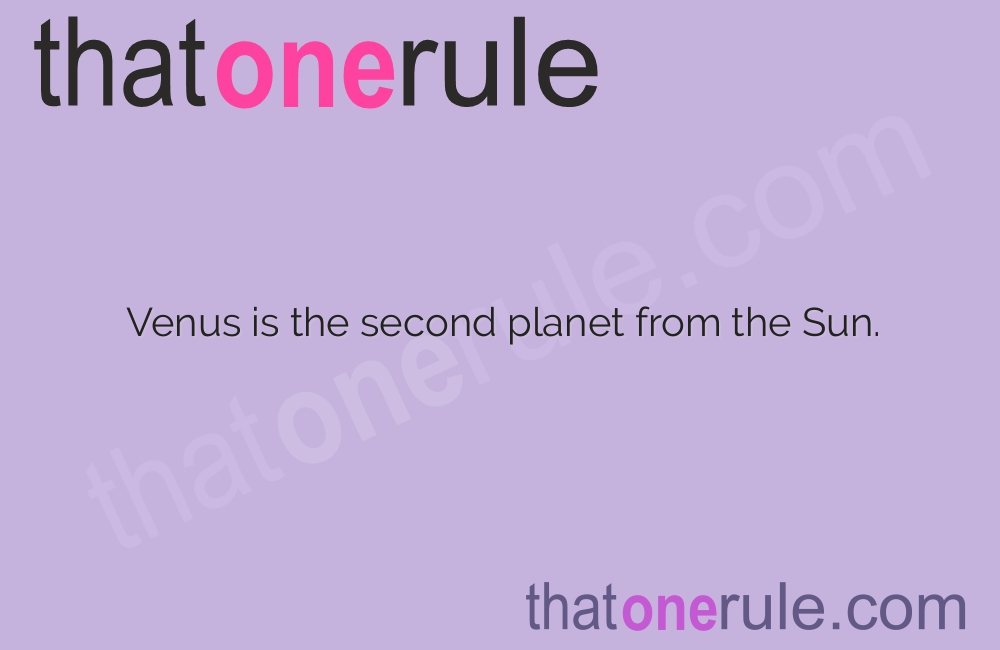Venus Fun Facts

Venus is the second planet from the Sun.
Venus is often called Earth’s sister planet due to their similar size and composition.
Venus has a thick atmosphere consisting primarily of carbon dioxide.
The surface temperature on Venus can reach a scorching 900 degrees Fahrenheit (475 degrees Celsius), making it the hottest planet in our solar system.
Venus has no moons or rings.
Venus takes longer to rotate on its axis than it does to orbit the Sun, meaning a Venusian day is longer than its year.
Venus has the longest rotation period of any planet in our solar system – it takes 243 Earth days to complete one rotation.
Venus is named after the Roman goddess of love and beauty.
Venus is often called the evening star or morning star because it is one of the brightest objects in the night sky.
Venus has the most circular orbit of any planet in our solar system.
Venus experiences retrograde rotation, meaning it spins in the opposite direction of its orbit around the Sun.
Venus has a very dense atmosphere that creates a greenhouse effect, trapping heat and causing extreme temperatures.
Venus has been visited by several space probes, including the Soviet Union’s Venera program in the 1960s and 1970s.
The surface of Venus is relatively young, with few impact craters indicating recent volcanic activity.
Venus has more volcanoes than any other planet in our solar system.
Venus Fun Facts part 2
Venus has a massive volcano called Maat Mons, which is 5 miles (8 kilometers) high and 120 miles (200 kilometers) in diameter.
Venus has a unique geological feature called coronae, which are thought to be formed by upwelling mantle plumes.
Venus has vast plains covered in volcanic lava flows, similar to those found on Earth.
Venus has extremely high atmospheric pressure, about 92 times that of Earth’s atmospheric pressure.
Venus has sulfuric acid clouds that completely enshroud the planet, creating a thick layer of haze.
Venus is the third-brightest natural object in the sky, after the Sun and the Moon.
Venus is often visible during the day, especially when it is in its crescent phase.
Venus has a retrograde rotation, meaning the Sun rises in the west and sets in the east on Venus.
Venus’ atmosphere is primarily composed of carbon dioxide, with traces of nitrogen and sulfur dioxide.
Venus has a weak magnetic field, making it more susceptible to the solar wind.
Venus has no magnetic poles, unlike Earth or other planets with significant magnetic fields.
Venus has the longest known volcanic eruption in our solar system, lasting for around 2.5 million years.
Venus has a rare astronomical event called the transit of Venus, where it passes directly between the Earth and the Sun.
Venus’ thick atmosphere creates a greenhouse effect, leading to a surface temperature hotter than Mercury, despite being farther from the Sun.
Venus’ atmosphere reflects about 70% of sunlight, making it one of the brightest objects in the sky.
Venus has unique cloud formations, including Venusian polar vortices and mysterious dark streaks called striae.
Venus has a strong atmospheric super-rotation, where the winds blow much faster than the planet’s rotation.
Venus’ super-rotation creates hurricane-like winds that can reach speeds of up to 250 miles per hour (400 kilometers per hour).
Venus has a tenuous ionosphere, a region of charged particles in its upper atmosphere.
Venus has no water on its surface, as it evaporates due to the extreme temperatures.
Venus has lava channels that stretch for hundreds of miles (kilometers) on its surface.
Venus has a distinct lack of tectonic activity, unlike Earth.
Venus has an atmospheric composition that makes it invisible to radar, making it challenging to study its surface.
Venus has a thick layer of clouds that constantly traps the Sun’s heat, causing a runaway greenhouse effect.
Venus has a day/night cycle that lasts about 117 Earth days.
Venus has a sulfuric acid rain that evaporates before it reaches the surface.
Venus’ surface is covered in vast, flat plains called planitia.
Venus has a high density, indicating that it has a substantial iron core.
Venus has distinct highland regions called terrae that are not found on other planets in our solar system.
Venus has a unique atmospheric phenomenon called a Venusian halo, caused by sunlight reflecting off the planet’s clouds.

